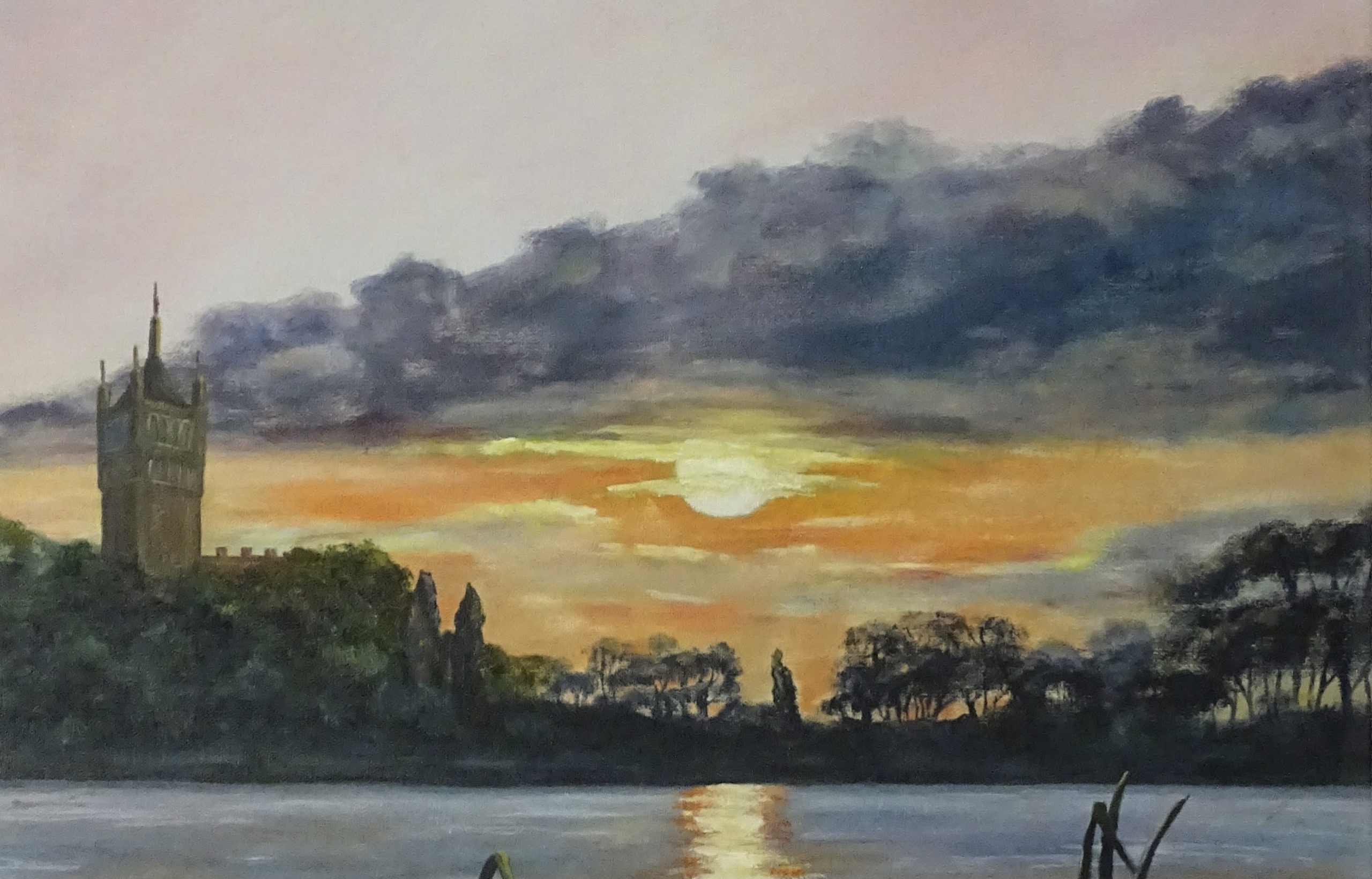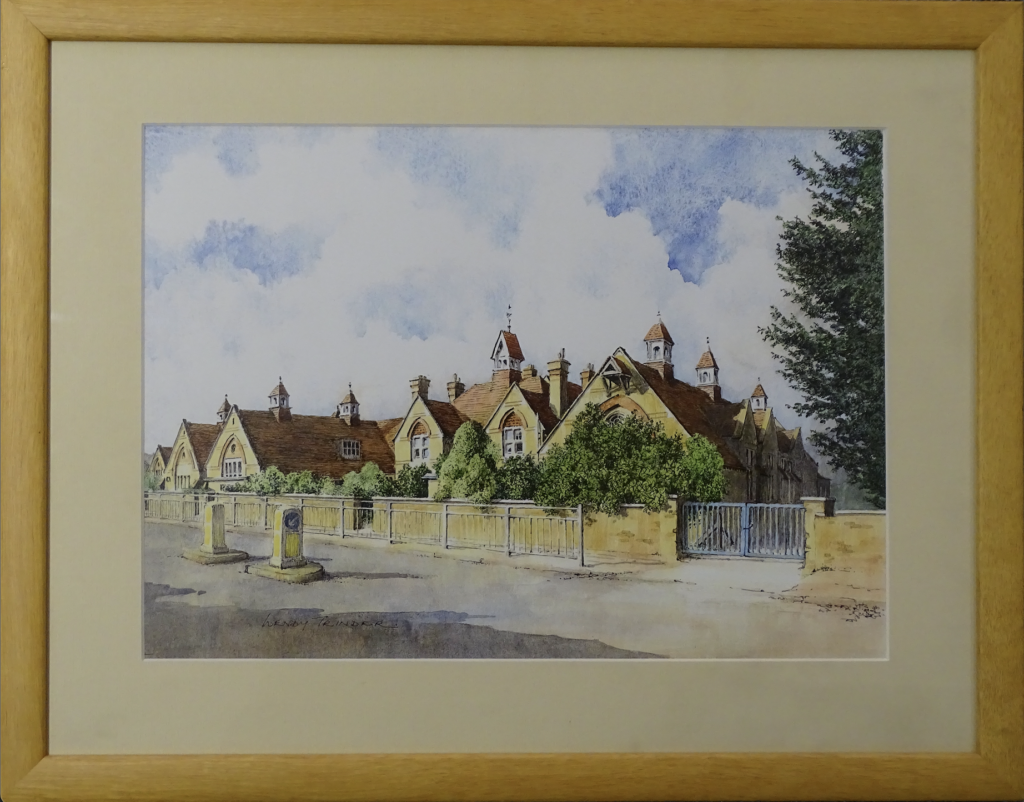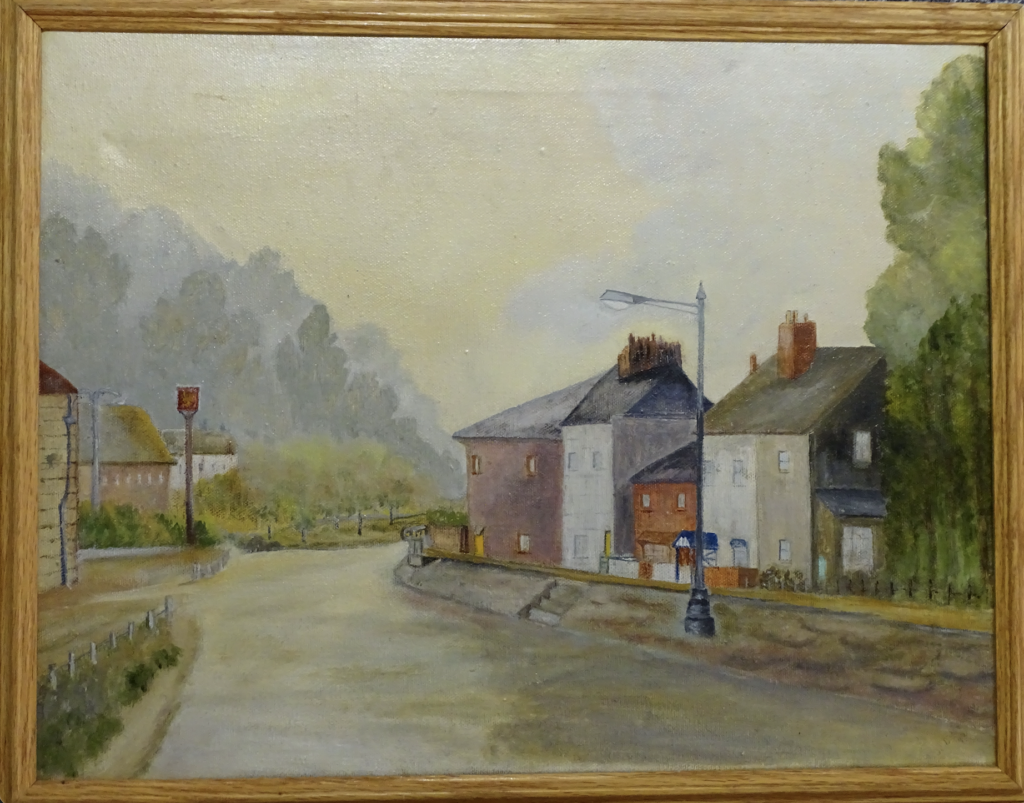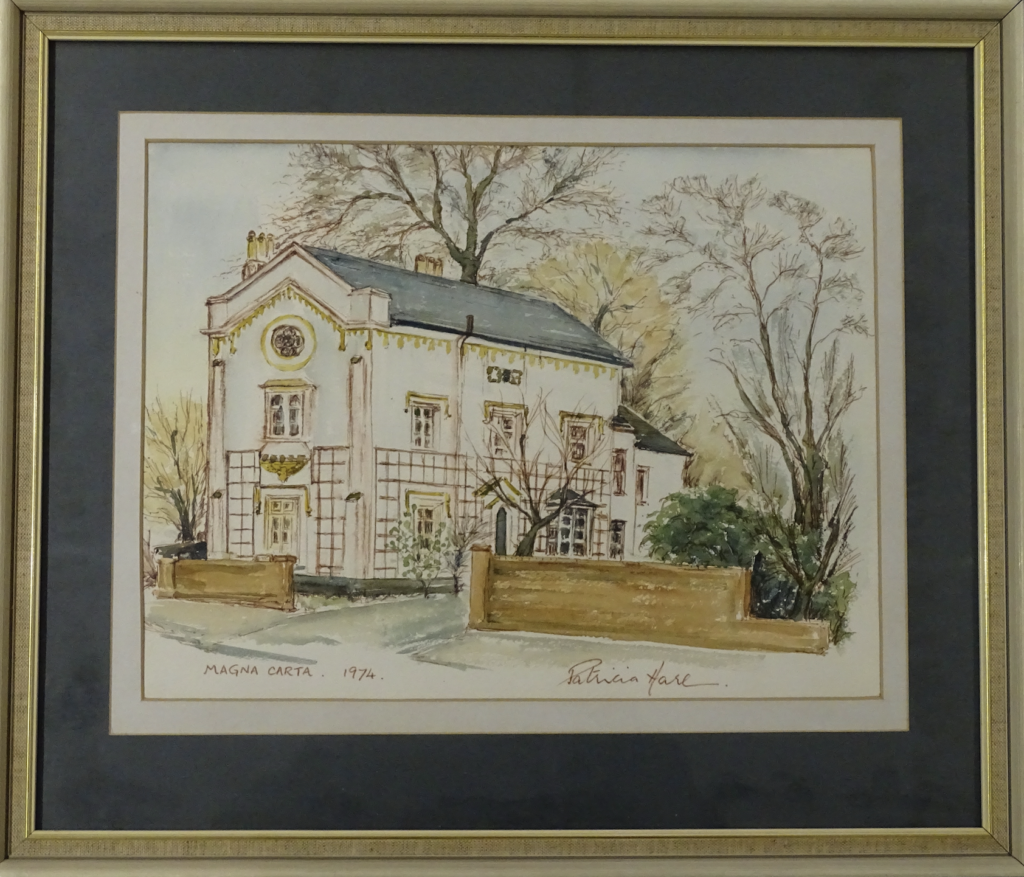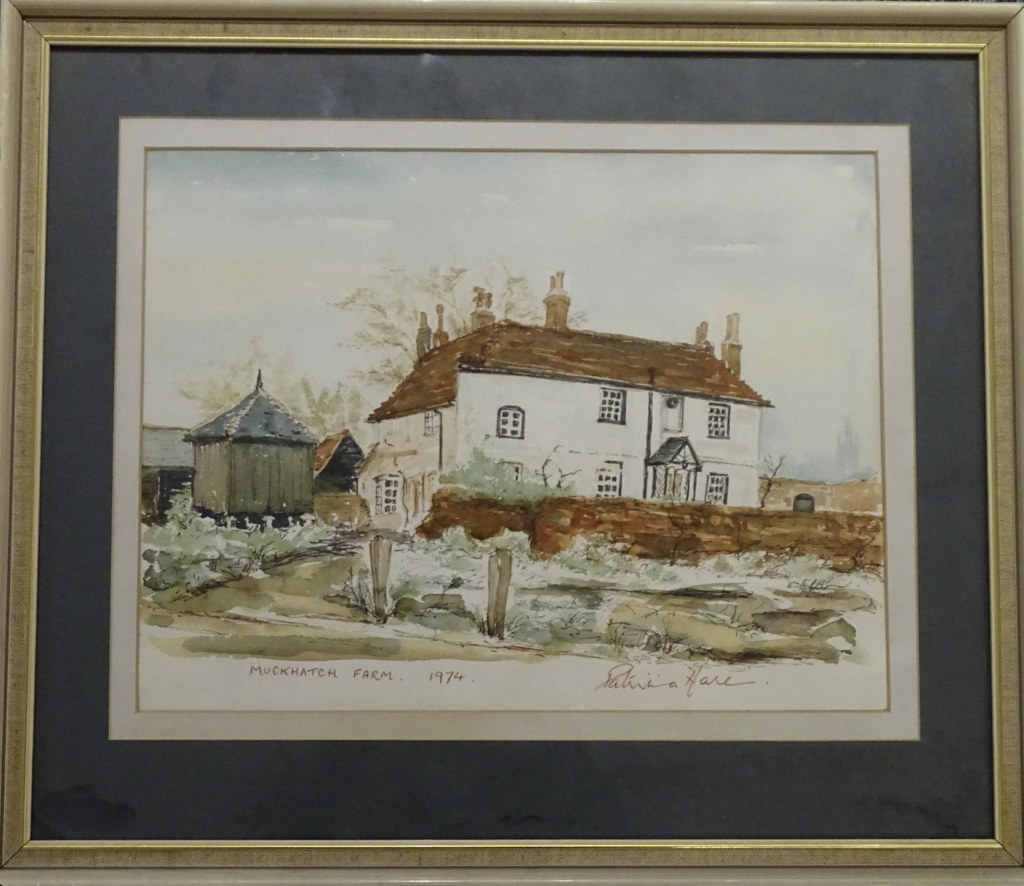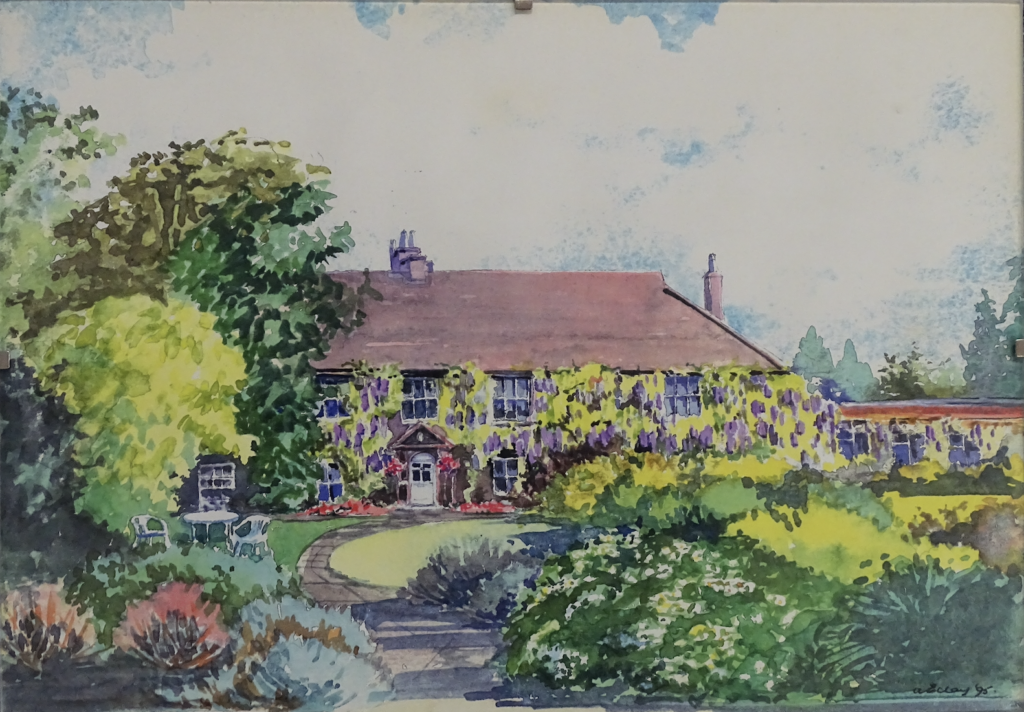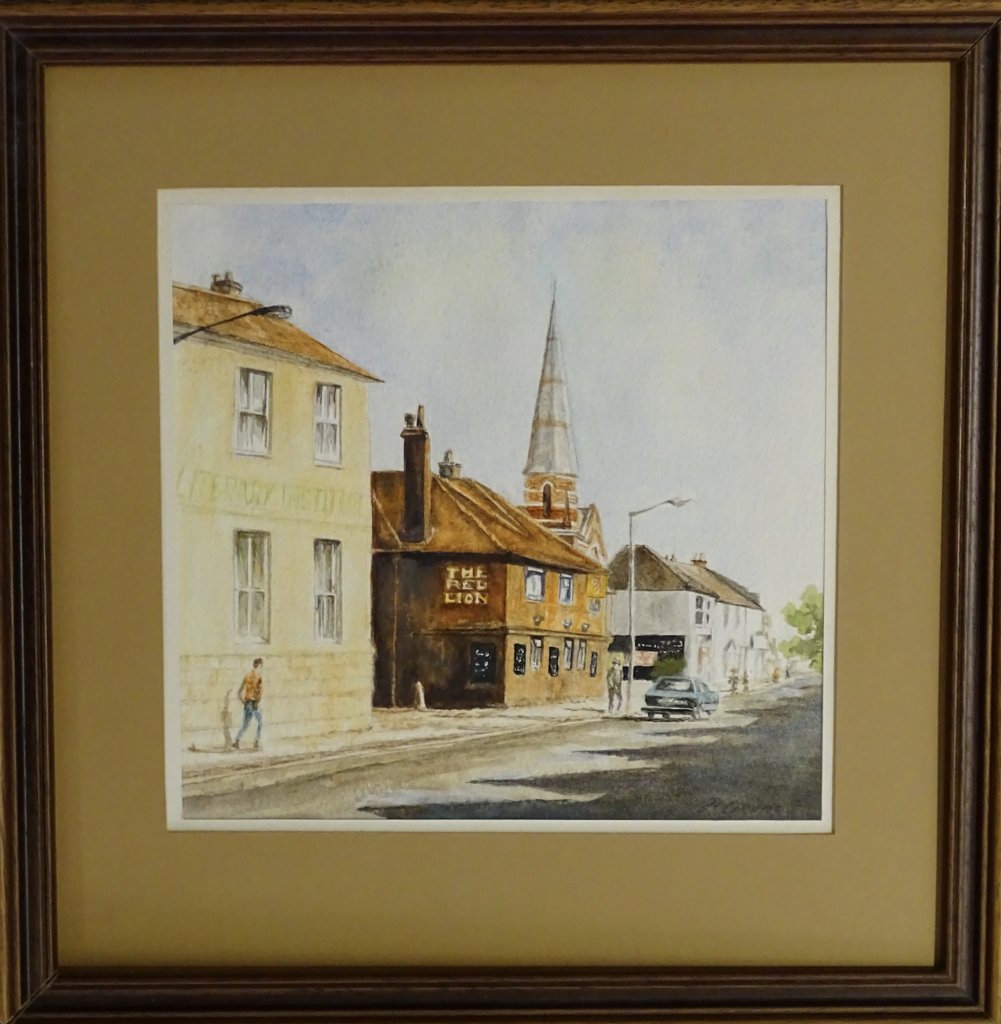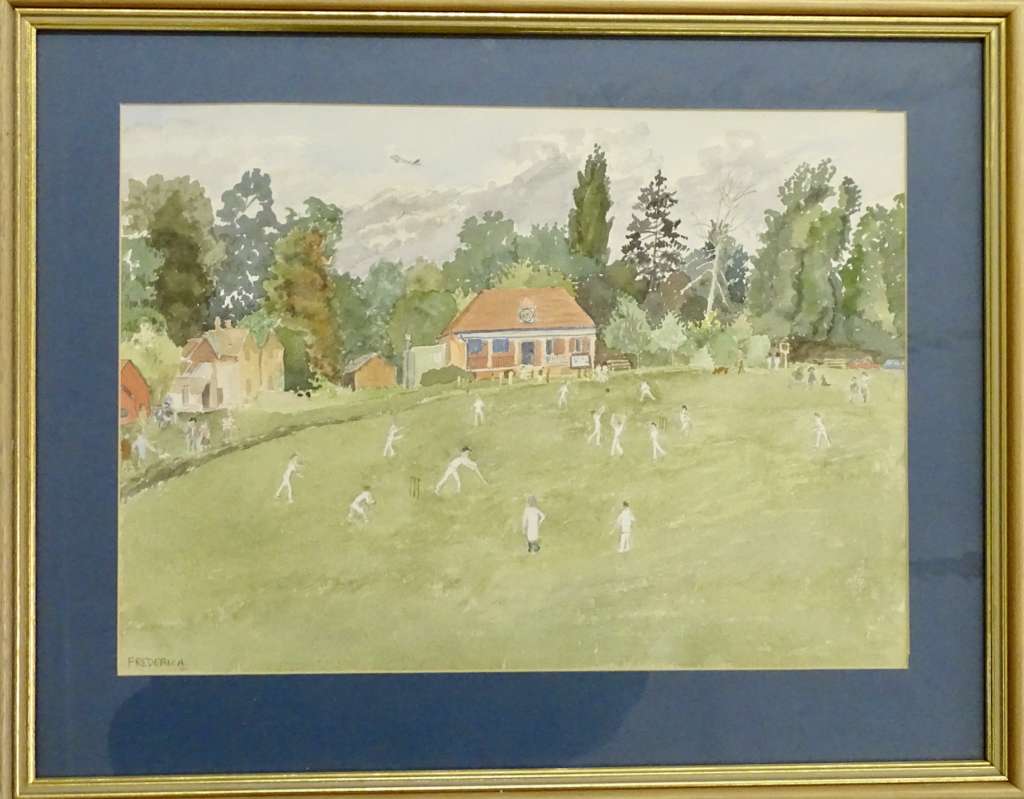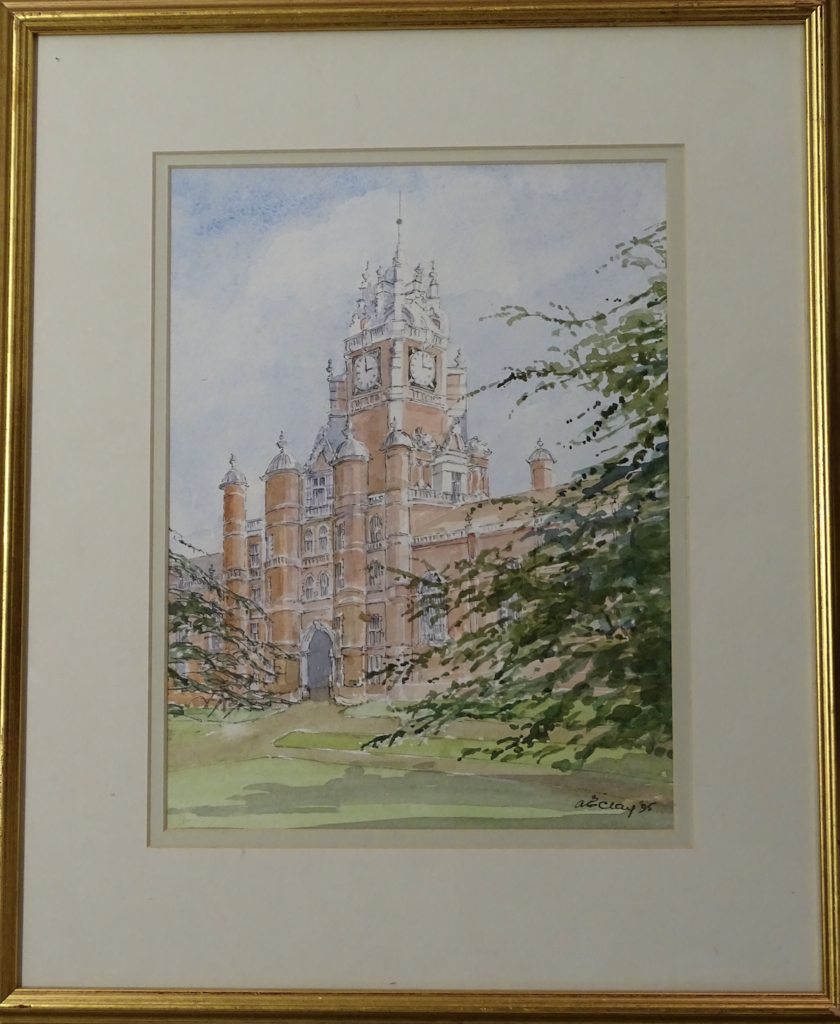Picturing Egham – Part 3
Read Part 1 here
Read Part 2 here
The final section of this exhibition features the works of women artists in the late 20th and early 21st centuries. Our journey ends with a collective of artists who were committed to register the moments which shape the local community to this day.
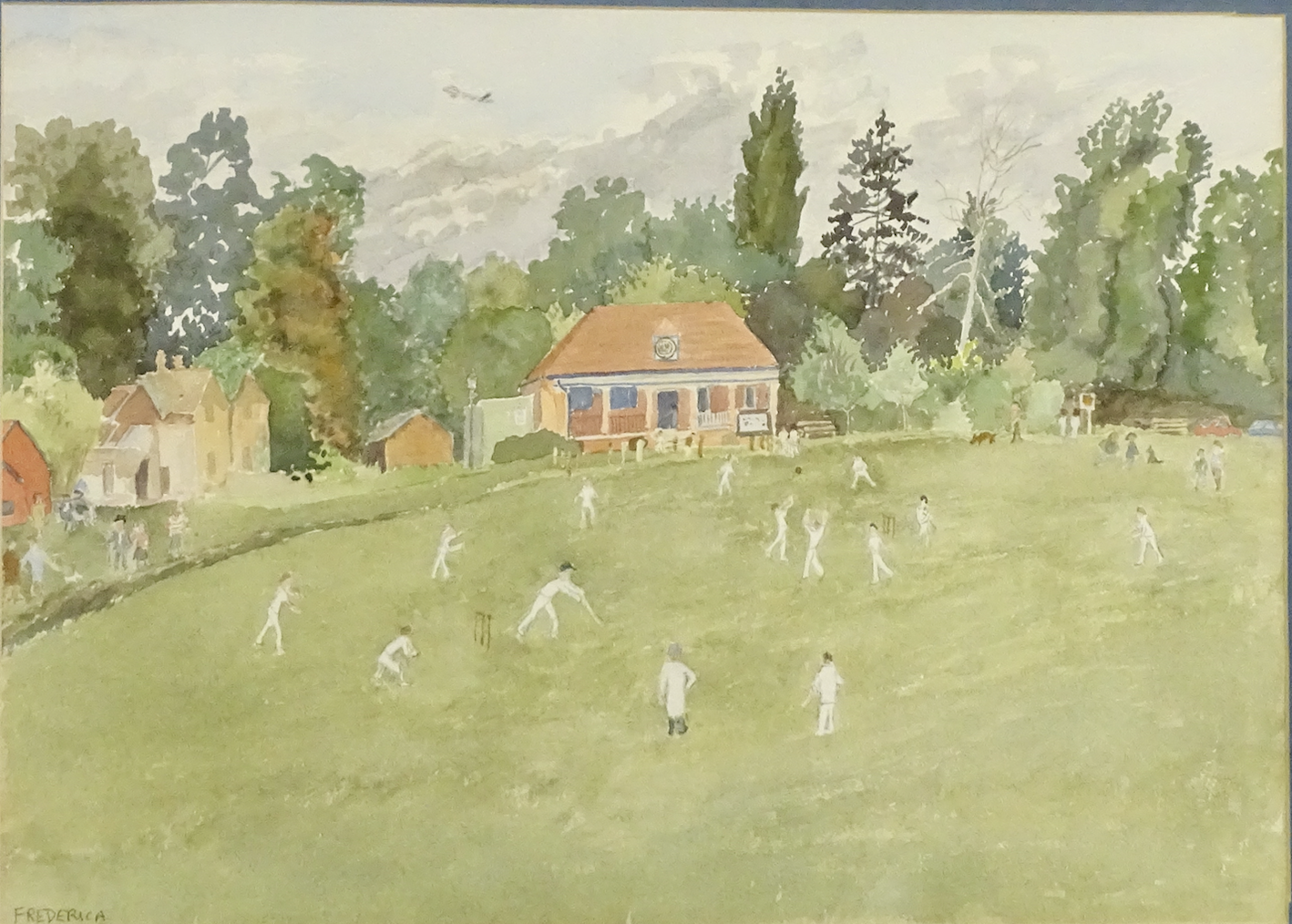
Art and Community
As shown on our project Memories of War, Egham was heavily affected by the Second World War. As a result, the population had to work together to rebuild the community during the post-war period.
The gap in our collection of artworks dated from the war period reflects the shift in the community’s concerns. Although this does not mean no artworks of the local area were produced in this period, it illustrates how the local efforts were redirected to the recovery of the local community.
This begins to change towards the end of the 20th century. While we begin finding more works of art produced during this period, there is also an effort in the local area to build an artistic community. In 1964, the Runnymede Art Society was formed, followed by the Virginia Water Art Society in 1966.
These societies were crucial for the development of a sense of community among the local artists. Many of the women whose work we explore in this section collaborated with both societies, taking part in their exhibitions and events.
This local effort was even internationally recognised. In 2011, Jean McDonnell, now chair of the Virginia Water Art Society, organised a literary and artistic exchange programme between the Runnymede Art Society and artists and poets from USA. While this strengthened the collective spirit of our local artists, it also promoted their achievements across the ocean.
The focus on community-building is evidenced in the paintings shown in this section. Our last journey on this tour takes us through the history of places and events depicted in the women’s works. While exploring the memories associated with the scenes, we also explore the lives and achievements of the women behind the canvases.
The Egham Hythe school, which featured in the exhibition Educating Egham, was founded in 1884. It is still functioning today as a state school.
As a place directed at the younger generations of the area, schools are the heart of the community. The artist herself used to teach, as did many of the women explored here.
Wendy Trinder was one of the artists who were mostly involved with local artistic communities. She often displayed her works at the Virginia Water Art Society’s exhibitions, alongside many of the women artists of this exhibition.[1] In 2013, she received the Virginia Water Art Society’s Pat Hare Award.[2]
Mrs Cowdry portrays here an area at a time when this scene was about to change.

Top: Egham – The Glanty January 1956, Egham Museum P3594
Bottom: The Avenue, Egham look towards The Victoria Inn and The Glanty 1969, Egham Museum P59A
In the early 1970s, the Glanty area was reshaped to accommodate the construction of a motorway, M25, connecting Egham to other areas surrounding Central London.
While conveying local cottages, Cowdry incidentally registered an important moment for Egham, as the lives of the community were about to change.
Despite the importance of a motorway for the Egham community to connect to the surrounding area, the construction led to some buildings being demolished. The Magna Carta House was one of them.
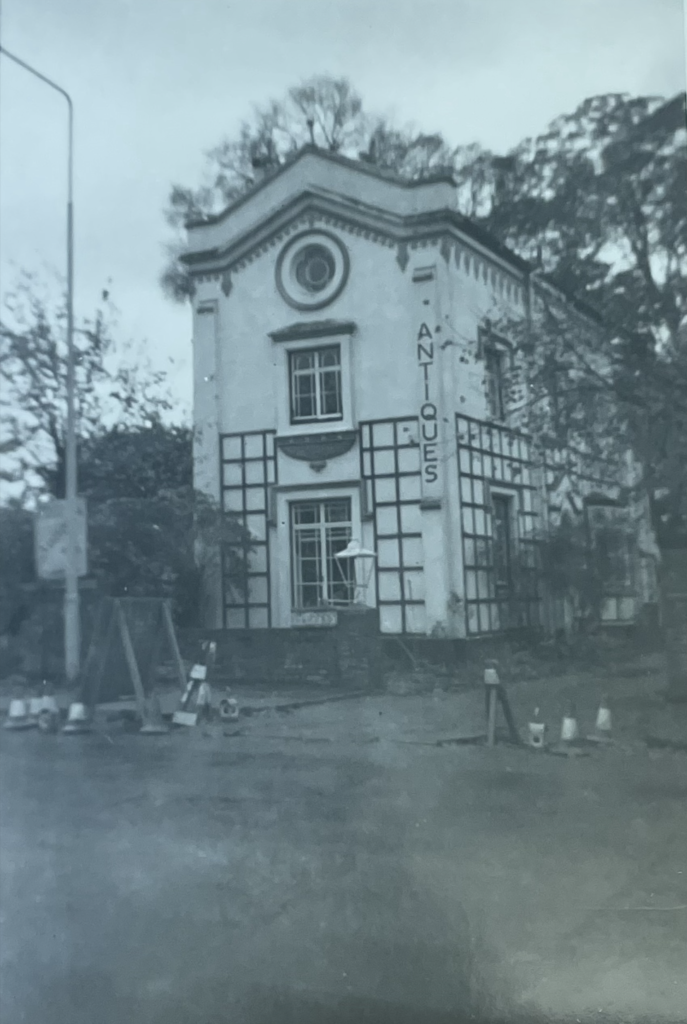
Credit: Egham Museum P2140
This Regency cottage built in 1803 was located facing West, towards the Runnymede meadows. Named after one of the most important events for local history, the house was a symbol of Egham’s past. Hare’s depiction, made a year before the demolishing, eternalises the building.
Hare was, in fact, of the most important artists of the local area. She founded the Virginia Water Art Society in 1966, and was vice-chair and committee member until 1996. In addition to her important work for the local artistic community, Hare was also a teacher, and never shied-away from sharing her immense artistic knowledge. Those who met her remember her as a ‘wonderful woman’ with great artistic achievements. Following her death, the Virginia Water Art Society founded the Pat Hare Award.
Hare’s other artwork in our collection is another visual memory of a building which no longer exists: Muckhatch Farm, located between Thorpe Green and Rosemary Lane.
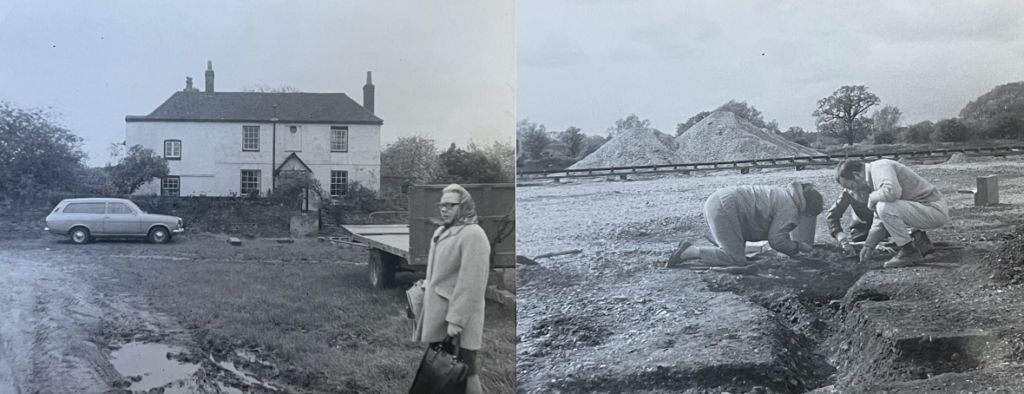
Credit: Egham Museum P487A; Right: Thorpe – Muckhatch Farm 1972
Credit: Egham Museum P2473
The history of Muckhatch Farm dates to the 13th century when, according to local tradition, a secret monk’s passage was built from the farm to St. Ann’s Hill. While this is yet to be confirmed, there was, in fact, a local area registered in 1346 as Le Mukelond. The name changed in 1510 to Muckhacche, and in 1515 to Mukhatch.[3] In c.1618 the farm became in possession of Edward Crosswell, and old servant of Queen Elizabeth I, and keeper of the Egham Walk in the forest.
In 1972, there were excavations in the farm, which resulted in many items – including aurochs bones – to be donated to the Museum. While the building itself is no longer there, Muckhatch’s presence in our collection, either through the objects found or through Hare’s painting, is a reminder of its relevance for the local history.
Alice Clay is another example of a local artist whose practices are community-driven. In addition to being part of the Virginia Water Art Society (alongside her husband Frederick Clay, also an artist) and Runnymede Art Society, thus exhibiting alongside many of the women explored in this exhibition, she was also a teacher to community groups.
In this colourful depiction of Manor Farm, Clay portrays a building whose past and present activities were of high importance for the local area.
The building was erected in the 16th century, and the original planning arrangements are significant for the evolution of post-medieval architecture. Previously, houses of a high social status such as Manor Farm’s had a large central hall extending through the full height of the building, flanked at either end by rooms on two storeys. By the middle of the 16th century, increasing prosperity and demand for more comfort and privacy challenged the communal spaces of medieval buildings. The most enduring solution found to these new demands are illustrated by Manor Farm’s architecture. In fact, it became so successful that houses continued to be based off of it until the late 19th century.[4]
In the first half of the 20th century, Manor Farm provided milk to local schools. Although farm houses were exempt of evacuation during the Second World War, Mary Scott, whose grandfather rented the farm in 1881, records having ‘evacuees […] and a few bomb scares.’[5]
Today, Manor Farm still stands as a Day Centre. The Centre was inaugurated on the 18th March 1971, and many groups and societies were invited. The Women’s Royal Voluntary Service, upon receiving an invitation, commented that they considered ‘Egham as a shining example of the harmony there can be between Local Authority and Voluntary Organisations when a situation of genuine mutual aid exists.’[6]
The High Street is at the core of Egham’s life. In particular, the two buildings visible in Corner’s painting – the Literary Institute and the Red Lion Pub – are still important to the local community today. Therefore, this tour could not avoid passing by the Egham Museum’s building and its neighbours.

Credit: Egham Museum P73A
Although much of the area surrounding the high street has – and is still being – changed, these two buildings have been in place for centuries.
The Red Lion dates back to at least 1651. Initially an inn, it acquired the building next door in 1799 and turned it into ‘Assembly Rooms’ for entertainment. After officially becoming the Literary Institute in the 19th century, the building next door is now home to the Egham Museum.
Pat Corner also displayed her works at local exhibitions alongside Trinder, Hare, and Clay.[7] The connection between these women’s works goes beyond depicting spaces and buildings relevant to the local community, as they became themselves embedded in these collectives.
Frederica Dowson, another local artist who exhibited with the Virginia Water Art Society, registers here one of the most important activities for the local community.[8]
The Green, as the field is called, has been used for cricket matches since at least the 18th century. In the 1740s, a royal cricket match was organised by Frederick, Prince of Wales (who was killed indirectly by a cricket ball in 1751). It is believed that King George II and his son William Augustus also participated in this game.[9]
The field is not only a symbol of the historical relevance of cricket for the area. To this day, many local teams gather family, friends, and cricket-lovers around the field – illustrated on Dowson’s depiction – to watch the sport that has been such an important part of local life for centuries. After each game, it is usual to find the team and supporters at the Barley Mow pub, which further strengths this activity’s connection to the community.
This has also been described by the Scottish writer Margaret Oliphant (1828-1897) in her book Neighbours on the Green (1889):
‘The Green itself was not like the trim and daintily kept greensward, with orderly posts and railings, which is to be seen in many suburban hamlets. It was long, irregular, and just wild enough to be thoroughly natural. The lower end near the Barley Mow was smooth and neat, the best cricket ground that you could find in the neighbourhood. […] Many a cricket match was played upon the lower Green, and on the bright summer Saturdays when the cricket parties came, there was often quite a pretty little company from the surrounding houses to watch them, and a great traffic went on at the Barley Mow.’[10]
Royal Holloway continues to be portrayed in art. As a local landmark, it influenced many artists beyond the Dallen sisters. In her watercolour, Clay reminds us that the college is still a central point for social, artistic, and cultural dynamism in the area.
The front view of the building, portrayed here amidst the trees between the North Tower and the gate, becomes a symbol of the historical and cultural impacts of Royal Holloway on the local community.
The final stop on this journey is a depiction by another woman whose artistic career included participating at local exhibitions. In this landscape, Holland portrays a sunset at Lake Thorpe with the Holloway Sanatorium Tower in the background.
This work is, on the one hand, another symbol of the work of Thomas Holloway in the area. Although the building is no longer functional as a sanatorium, it still stands, peeking through the vast landscape. Holland’s work is a reminder that the local area is important not only due to its social contributions, but also due to its natural beauty.
References
[1] Virginia Water Art Society, Winter Exhibition 1988 Catalogue
[2] ‘Virginia Water Art Society Winter 2013 Exhibition’, in Virginia Water Art Society Diary, 9 December 2013 https://virginiawaterartsociety.blogspot.com/2013/12/virginia-water-art-society-wintere-2013.html
[3] DOC4506, Egham Museum
[4] DOC1479, Egham Museum
[5] DOC4954, Egham Museum
[6] DOC2922, Egham Museum
[7] Virginia Water Art Society, Winter Exhibition 1988 Catalogue
[8] Ibid.
[9] DOC5252, Egham Museum
[10] Margaret Oliphant, Neighbours on the Green (London: Macmillan & Co., 1889), pp. 237-8
Acknowledgments
This online exhibition was curated by Cátia Rodrigues as part of a PhD work placement supported by TECHNE/AHRC and Royal Holloway.
Many thanks to Egham Museum Volunteer Mimi Markham, whose research on the Dallen family informed part 2; to Jean McDonnell for her ‘guided-tour’ through the Virginia Water Art Society’s archives and memories for part 3; and to Egham Museum Curator Amy Stone for her support with the project.

